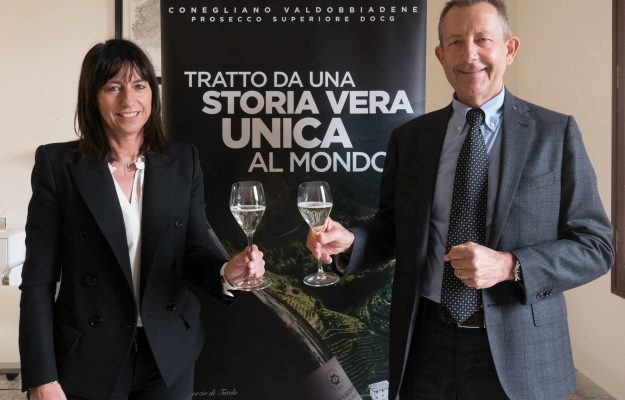The Hills of Conegliano Valdobbiadene Prosecco DOCG, a UNESCO heritage site, are the historic center of the Prosecco world (and according to the Qualivita Report, its production value in 2021 was 187 million euros, ed.). To celebrate its first 60 years of activity, the Conegliano Valdobbiadene Prosecco DOCG Consortium, led by Elvira Bortolomiol president, and directed by Diego Tomasi, have launched two projects — the “Green Academy” and the “Wine Tourism Lab” — that are looking towards the future, in the long-term, and focus on two increasingly important assets in the great wine territories: sustainability and tourism. Specifically, The Green Academy project, will be an “incubator” of research, studies, contents and new ideas working more and more in a structured, aggregated and concrete way for territory sustainability. “The Green Academy project”, a note explained, “traces a significant step in the path that the Consortium has been pursuing for at least a decade, keeping an eye towards the future as well as improving and preserving the environment, the landscape and viticulture”.
“We are very proud and also motivated to proceed in this direction, because the Green Academy project is a path that will allow us to put our knowledge to good use, in collaboration with experts in the various sectors concerning this issue”, Elvira Bortolomiol said. “Our territory and our community are precious gifts, and we have the precise duty to make the most of our knowledge and the resources we have available, for them, to be able to offer a tangible contribution to our territory, and be a reference point for other companies as well”. “The Green Academy project will study the most urgent issues that the global environmental agenda must confront, and then distribute them on the territory”, Diego Tomasi added. “First of all, there is climate change. We already have a collaboration underway with the bank, Banca Prealpi and the University of Cantabria, the objective of which is to formulate forecast models of the extreme atmospheric events that could occur on our hills between now and 2030, 2050 and 2100”.
In the meantime, a group of Internationally renowned Egyptologists has studied, specifically for the Consortium, how the ancient Egyptians managed to cultivate vines in extreme climatic conditions. Their studies started as far back as 3.000 BC. The complete results are expected to be available by mid-2023. They will be definitely give us concrete ideas on how to implement mitigation measures on the Prosecco DOCG hills. “Concerning the drought issue, instead, we have already begun”, Director Tomasi added, “focusing our attention on recovering, conserving and reusing rain and spring water”. As a matter of fact, specific and substantial funding was provided to build small basins to collect runoff water, in the fifth supply chain competition presented a few days ago, which the University of Padua will curate. Furthermore, we are moving together with the Municipalities of the denomination, the trade associations and the Associazione di Bonifica Sinistra Piave to propose the recovery of water from the Piave River.
Another very important issue in the field of sustainability is land use, which the Green Academy project will address by constructing a permanent observatory. To date, we can emphasize that 30% of the Denomination’s surface is used for viticulture, 57% for woodlands, 9% for other uses and 4% for urban use. There is, therefore, a very rich biodiversity — one of the reasons that Unesco granted recognition — which must be protected. The feasibility study for mobility completely excluding transporting goods in large vehicles and traditional traction vehicles has begun together in close collaboration with other partners (Municipality of Valdobbiadene, Coldiretti, Banca Prealpi, Unesco Association). The Consortium has been making available tools to strengthen skills, for quite a while now, to deal with these issues, especially for the technical office, which is assuming new professionals. Furthermore, the consolidated activities of the Consortium regarding environmental health will continue, such as the partnership with the Symbola Foundation and updating the Viticultural Protocol. The Consortium is a member of the Symbol Foundation, which has been aggregating Italian excellence for years in order to promote their quality and support sustainable behavior, goals that are consistent with those of the Consortium.
Another fundamental objective of the Consortium is to involve new generations that will be entrusted with the future of the denomination, which is why the Wine Tourism Lab project was created. Its dual purpose is to act as a kind of glue amongst the various professional figures in the area, while at the same time to create greater awareness amongst young people of the broader opportunities this area will offer in the coming years. That is, no longer just wine, but beside it also landscape, beauty, healthiness, food, free time nature, all words that merge into one: wine tourism.
The Conegliano Valdobbiadene Prosecco DOCG Consortium promotes activities aimed at improving the territory through cultural and training courses for the generations who will be called upon to manage Conegliano Valdobbiadene. “We need to have a broader and more far-sighted view of the potential of the denomination, and be aware that Conegliano Valdobbiadene Prosecco Superiore DOCG will always be the symbol of these hills and new economic opportunities will arise from it. The Consortium”, a note concluded, “is now laying the foundation to make the players on the territory more and more competent in managing visitors, and especially welcoming them, which boosts the enological soul of the territory. To achieve this goal, it will be necessary to act on training for all the professional figures involved, so that the level of the offer is distinguished by a high profile and constant updating”.
Copyright © 2000/2025
Contatti: info@winenews.it
Seguici anche su Twitter: @WineNewsIt
Seguici anche su Facebook: @winenewsit
Questo articolo è tratto dall'archivio di WineNews - Tutti i diritti riservati - Copyright © 2000/2025









































































































































































































